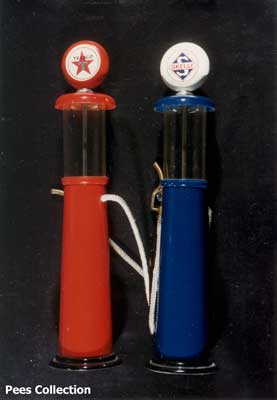 |
||||||
DISPENSING GASOLINE
 |
Handmade (in Oklahoma) models of visible (glass) gasoline pumps of the early 1930’s. |
Introduction and Glass Pumps
Some of the senior readers may remember gasoline stations that had pumps with cylindrical glass chambers at the top. You could see the gasoline in them and sometimes it was a light reddish color (ethyl?). In fact, they were called visible pumps. The author recalls signs near the pumps which advertised the gas for 10 cents/gallon, often expressed as 10 gals. for $1.00. The glass cylinders had graduation ticks from one to ten gallons in descending order. That was in the 1930’s, but the glass tops were around in the 1920’s too.
As time went on the pumps and stations became more modernized and the graduated glass cylinders disappeared. Looking back, there was a sense of satisfaction when you could see the level of gasoline moving down on the cylinder’s scale (gal. #1 was at the top) letting you know at a glance how much of the gasoline your thirsty tank was taking. Of course, at the end, the buyer would always lift the hose to drain the last cupful of gas that might have lurked in the bend but which was technically part of the purchase.
When the later fancy meters displaying gallons, tenths of gallons and dollars and cents (which you have to take the meter’s word for) came in, some of the old glamour was lost. One custom still survives (more or less): lifting the gooseneck to get the last drop. But what happened to the window wipe when you pull up to the full-serve pump these days?
| © 2004, Samuel T. Pees all rights reserved |
|